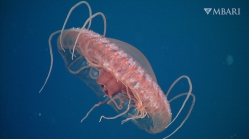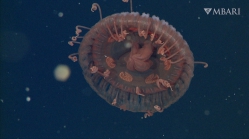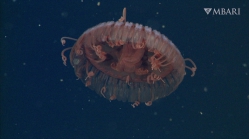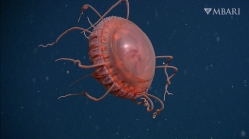WoRMS taxon details
Atolla reynoldsi Matsumoto, Christianson, Robison, Haddock & Johnson, 2022
1568662 (urn:lsid:marinespecies.org:taxname:1568662)
accepted
Species
marine, brackish, fresh, terrestrial
recent only
Matsumoto, G. I.; Christianson, L. M.; Robison, B. H.; Haddock, S. H. D.; Johnson, S. B. (2022). Atolla reynoldsi sp. nov. (Cnidaria, Scyphozoa, Coronatae, Atollidae): A New Species of Coronate Scyphozoan Found in the Eastern North Pacific Ocean. <em>Animals.</em> 12(6): 742., available online at https://www.mdpi.com/2076-2615/12/6/742 [details] 
Holotype CAS CASIZ no. 233651, geounit Monterey Bay
, Note The type specimen was collected on 30 June...
Holotype CAS CASIZ no. 233651, geounit Monterey Bay [details]
From editor or global species database
Type material The type specimen was collected on 30 June 2021 at 3189 m depth, at 35°29'58.0776” N and 123°59'55.536” W in Monterey Bay, California. The holotype specimen and three paratype specimens have been deposited at the California Academy of Sciences (Holotype: CASIZ no. 233651; Paratypes: CASIZ 233650, CASIZ 233652, and CASIZ 233653). Two additional paratypes are housed at the Monterey Bay Aquarium Research Institute (MBARI). A total of ten specimens have been collected between April 2006 and June 2021 (Table 1) in Monterey Bay (eastern North Pacific Ocean) at depths between 1013 and 3189 m. [details]
Etymology Named after the first volunteer at the Monterey Bay Aquarium (Jeff Reynolds) who guarded a beached whale on Del Monte Beach...
Etymology Named after the first volunteer at the Monterey Bay Aquarium (Jeff Reynolds) who guarded a beached whale on Del Monte Beach overnight so that the Aquarium could retrieve it and prepare it for eventual overhead display. [details]
WoRMS (2024). Atolla reynoldsi Matsumoto, Christianson, Robison, Haddock & Johnson, 2022. Accessed at: https://www.marinespecies.org/aphia.php?p=taxdetails&id=1568662 on 2024-04-25
Date
action
by
![]() The webpage text is licensed under a Creative Commons Attribution 4.0 License
The webpage text is licensed under a Creative Commons Attribution 4.0 License
original description
Matsumoto, G. I.; Christianson, L. M.; Robison, B. H.; Haddock, S. H. D.; Johnson, S. B. (2022). Atolla reynoldsi sp. nov. (Cnidaria, Scyphozoa, Coronatae, Atollidae): A New Species of Coronate Scyphozoan Found in the Eastern North Pacific Ocean. <em>Animals.</em> 12(6): 742., available online at https://www.mdpi.com/2076-2615/12/6/742 [details] 
 Present
Present  Present in aphia/obis/gbif/idigbio
Present in aphia/obis/gbif/idigbio  Inaccurate
Inaccurate  Introduced: alien
Introduced: alien  Containing type locality
Containing type locality
Holotype CAS CASIZ no. 233651, geounit Monterey Bay [details]
From editor or global species database
Diagnosis Atolla reynoldsi sp. nov. can have from 26–39 tentacles and rhopalia. The overall shape is flattened although the center zone is a rounded dome, albeit not very tall (Figure 1). The tentacles in situ are usually coiled and a hypertrophied tentacle has not been observed. There are ~nine lateral ridges along the pedalia that have some spikes of various heights (Figure 5b–d). The gut has a distinctive Greek-cross morphology (Figure 6c). Diagnostic characters separating this new species from extant Atolla species include the spiked ridges and papillae on the exumbrellar surface of the rhopaliar pedalia, the ability to coil the tentacles, the Greek-cross gut morphology, and the lack of a hyptertrophied tentacle. The gonads are oval when immature but become large and horseshoe-shaped when mature. The radial septa are straight or slightly divergent and extend beyond the coronal muscle. [details]Etymology Named after the first volunteer at the Monterey Bay Aquarium (Jeff Reynolds) who guarded a beached whale on Del Monte Beach overnight so that the Aquarium could retrieve it and prepare it for eventual overhead display. [details]
Remark Systematic remarks: The order Coronatae is identified by the separation of the exumbrella into two concentric zones by a circular coronal groove. The central zone is a circular disc or dome while the marginal zone is divided by radiating grooves into thickened pedalia, with peripheral lappets. The presence of more than eight rhopalia place it into the family Atollidae, which is currently monogeneric.
The previously described number of rhopalia in the genus Atolla is 16–32. However, Atolla reynoldsi sp. nov. has up to 39 rhopalia and the Atolla sp. A and Atolla sp. B have up to 64 rhopalia. While it is possible that these types with 32 or more rhopalia might be a new genus, we are not comfortable at this time in making this recommendation as we have not examined all 10 putative species or completed the molecular analysis for Atolla sp. A and Atolla sp. B. Therefore, we recommend that the new diagnosis for the family Atollidae be modified to include up to 64 tentacles and rhopalia. We are in the process of writing up new species descriptions for Atolla sp. A and Atolla sp. B as soon as we complete our molecular analysis of these two types. [details]
Type material The type specimen was collected on 30 June 2021 at 3189 m depth, at 35°29'58.0776” N and 123°59'55.536” W in Monterey Bay, California. The holotype specimen and three paratype specimens have been deposited at the California Academy of Sciences (Holotype: CASIZ no. 233651; Paratypes: CASIZ 233650, CASIZ 233652, and CASIZ 233653). Two additional paratypes are housed at the Monterey Bay Aquarium Research Institute (MBARI). A total of ten specimens have been collected between April 2006 and June 2021 (Table 1) in Monterey Bay (eastern North Pacific Ocean) at depths between 1013 and 3189 m. [details]





